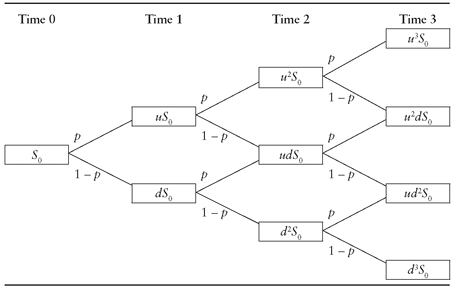Binomial trees (also called
binomial lattices) provide a natural way to model the dynamics of a random process over time. The initial value of the security
S0 (at time 0) is known. The length of a time period, Δ
t, is specified before the tree is built.
77 The binomial tree model assumes that at the next time period, only two values are possible for the price; that is, the price may go up with probability
p or down with probability (1–
p). Usually, these values are represented as multiples of the price at the beginning of the period. The factor
u is used for an up movement, and
d is used for a down movement. For example, the two prices at the end of the first time period are
u ·
S0 and
d ·
S0. If the tree is recombining, there will be three possible prices at the end of the second time period:
u2 ·
S0,
u ·
d ·
S0, and
d2 ·
S0. Proceeding in a similar manner, we can build the tree in
Exhibit 6.2.
The binomial tree model may appear simple because, given a current price, it only allows for two possibilities for the price at each time period. However, if the length of the time period is small, it is possible to represent a wide range of values for the price after only a few steps. To see this, notice that each step in the tree can be thought of as a Bernoulli trial
78—it is a “success” with probability
p, and a “failure” with probability ...


